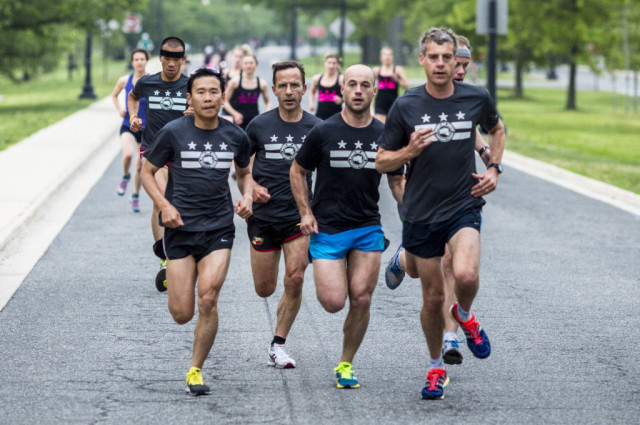
Cue an early scene from “Karate Kid.”
The kid himself walks into Cobra Kai dojo and discovers that his nemesis is the top student. If that wasn’t intimidating enough, the kid also encounters a meathead instructor, or sensei, as he’s laying out some raw facts.
“Pain does not exist in this dojo,” the sensei yells out, “does it!”
“No sensei!”
And so on.
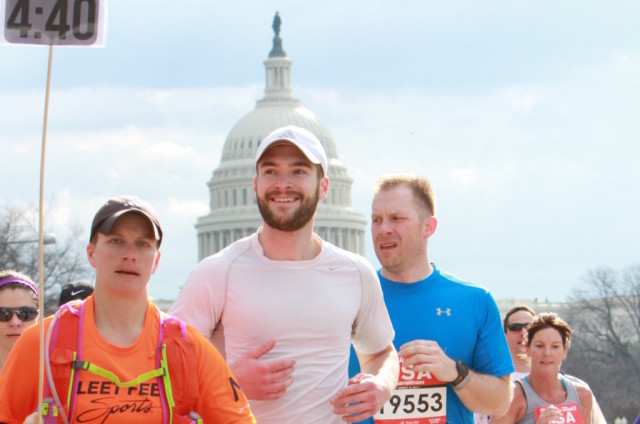
The number — 4:40 — looked like it belonged with a Bible verse. It bounced above Erica Ferrell, attached to a long stick, as she toted that sign through Columbia Heights, NoMa, Capitol Hill and Anacostia, her disciples followed.
In the end, her message was indeed the truth. She crossed the line at the Rock ‘n’ Roll USA Marathon in 4:40:06, right on schedule.
“I lost the last few people around mile 23,” she said. “They stopped to get water. I slowed down, but they started walking.”
Least she seem uncompassionate, it wasn’t Farrell’s job to hold her runners’ hands for 26.2 miles. She worked in some flexibility in her pacing for hydration, but she was to be the metronome that runners would be able to look to for consistency.
“When I was on my own, there were times that I thought about running ahead to finish it up,” she said. “But that wasn’t why I was here. I stuck to the plan.”
Pacing groups are marathon mainstays, and crucial for many novice marathoners to complete the race. Among the string of solitary runners, they pack up and their dozens of footsteps announce their presence. Spectators use them as reference points when trying to locate friends and family members in the middle of the race.
“People really look for them, either to hang on as long as they can or to gauge their pace,” she said. “I’ve run with plenty of pacing groups in my own racing and they’re good at helping you chill out and not rush. When you’re in the early miles of a marathon, you get eager and you want to see what you can do, but signing up for that group means a reminder that you need to run a pace you can maintain the whole way.”
Ferrell, a Thurmont, Md. resident came to the job at the behest of Nate Nudelman, coach of the Navy Academy Marathon Team. He has a core group of pacers that have worked the Rock ‘n’ Roll USA Marathon and Half Marathon and its previous incantation as the National Marathon, a crew he supplements with Midshipmen who cut their spring breaks short to come and pace. For Ferrell, a 3:40 marathoner who has run more than a dozen and qualified for Boston at the California International Marathon (with the help of a pacing group), it was a chance to give back.
“I’ve run a lot of my PRs thanks pacing groups,” she said. “It’s a great opportunity to help someone else out.”
A four-hour marathon is pretty comfortable for her, so Nudelman’s initial assignment, for her to lead the 4:25 group, seemed like no sweat. When he moved her back to 4:40, she was a little concerned.
“They were looking for someone who can run four hours pretty comfortably, without any trouble,” she said. “But 4:40 was a little harder to maintain. I’m not used to that pace.”
Sure enough, she started out a little fast, just a few seconds per mile, but a few of her runners let her hear about it.
“They definitely know what the pace feels like, or is supposed to feel like,” she said. “They’ve been training at that pace for a while. I just told them to trust me. I made the adjustments after a few miles, shortened my stride, and [got back] on track.”
That banked time came in handy when the group hit mile seven’s uphill on Shorham Drive, climbing out of Rock Creek Park into Woodley Park. Running the hill can throw runners’ confidence askew, but Ferrell’s instructions aimed at defraying the curveball the incline threw at any attempts at an even pace.
“We tried to maintain that 10:40 pace, but I was more willing to slow down to keep the group together,” she said. “We had a long way to make up that time, and there wasn’t going to be anything to gain from dropping anyone that early in pursuit of the goal time. I just told them: Head up! Shoulders back! Relax! Keep your arms moving! I reminded people of their mechanics, because when you’re focusing on that, you’re not thinking about the dreaded hill.”
It turns out the time the group had sped up early on was closely offset by the climb. When they hit the top, they had broken even. Not bad for someone who had never run the course before.
“I can usually tell where I am with a pace,” she said. “If I’m going a little faster or slower, I can feel it.”
She ran with a Garmin watch to aid her pacing, but rarely consulted it.
The Rock ‘n’ Roll USA Marathon sets the pacing group target times based on the historical demand for pacers throughout the entire Rock ‘n’ Roll Marathon series. This year’s Rock ‘n’ Roll USA paces included 3:10, 3:30, 3:40, 3:55, 4:00, 4:10, 4:25, 4:40 and 5:00. The accompanying half marathon has 1:45, 2:00, 2:15, 2:30, 2:45 and 3:00 pace groups.
When the course flattened out in the second half, Ferrell saw her runners lock into a consistent pace, but she lost her pacing partner to injury. At the same time, some of her runners were also starting to tire and she saw herself as much a cheerleader as a pacer.
“Later on in that race, you just have to keep people going,” she said. “It get a little lonely in Anacostia and you have long stretches where you can see how far you have to go.”
Her secret weapon at that point was distraction.
“When they start to get negative, you just have to tell them, ‘you just have a little bit to go,’” she said. “Take it one mile at a time. I tell them the same things I tell myself when it gets rough, that I’m getting closer every step.”
She is considering running other races as a special needs guide, such as with the visually impaired runners at the Woodrow Wilson Bridge Half Marathon.
Ferrell made her own marathon debut in Portland, Ore. while her now-husband was deployed and she, then a military police officer in the U.S. Army, was looking for something to do.
“I didn’t know anything about marathons,” she said with a laugh. “I definitely didn’t know about pace groups. I sure would have learned a lot faster if I had one.”
With that in mind, along with her pacing, she hoped to leave her runners with some lessons she could impart about running technique and motivation during the marathon. And, the basics of how to run the time they want, especially if it means running her pace. That means speeding up a little before the water stops or toilets and getting back in the pack
“Just tell them to try to get ahead, because we’re going to keep going,” she said. “That’s the best you can do in those situations.”
Because the train doesn’t wait.
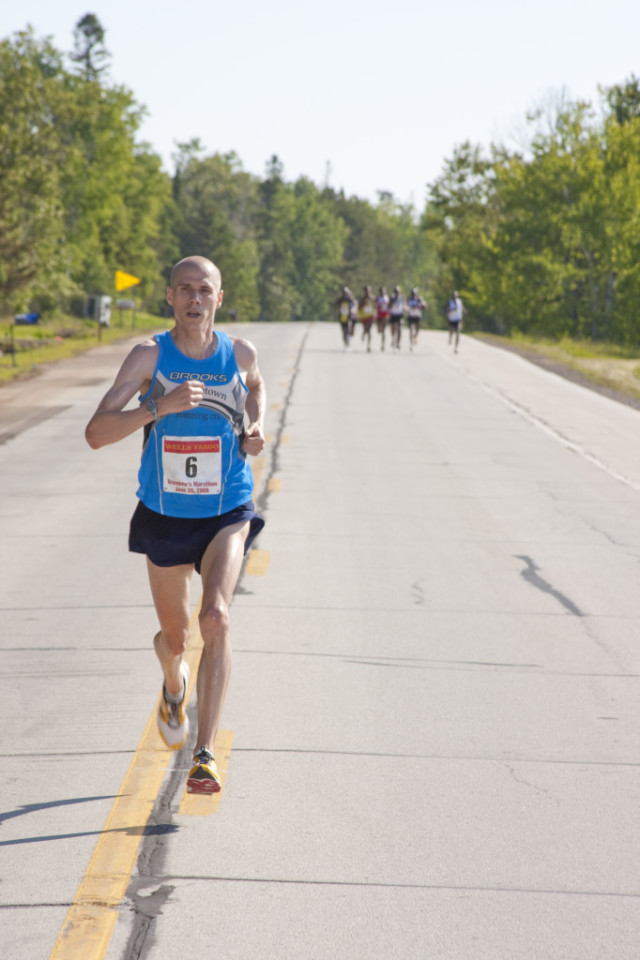
Running a marathon isn’t that hard, is it? You dedicate yourself to training for a few months, build up mileage and aim for a good effort on race day. I mean, some four million Americans crossed a marathon finish line last year, right?
Finishing, however, is one thing, and running well is another. How do you know if you’re ready to do more than simply endure? How do you know if you’re prepared to give it your best effort and run the marathon of your life?
Answers from some of this area’s best marathoners range from serendipity to grindingly hard work. The common thread is a confidence born of having done the workouts and logged the miles.
Better to Be Lucky …
While the science of training, diet, psychology and physiology — not to mention digital watches — have advanced over the decades, the surest way to run a good race remains to have good luck. Phil Stewart, now the Credit Union Cherry Blossom 10 Mile race director, is a case in point. Stewart ran his personal best 2:19:58 at the 1975 Boston Marathon, knocking more than six minutes off his best.
“That was a tailwind year,” Stewart says matter-of-factly. “I felt good throughout the race and at the finish thought I might have run 2:22 or 2:23, but I had no idea. In those days, splits were given in the middle of the various towns, like 6.7, 9.8 or 14.3. They didn’t even have a clock at the finish line.”
So Stewart finished what felt like a solid effort and relaxed in the depths of the Prudential Center parking garage, where race officials posted results as they became available. “I absolutely shrieked when I saw that I had broken 2:20,” Stewart says. “Years later I ran three hours exactly but never complained that I hadn’t gotten under — I had my two seconds when I needed them. I picked a good day to run well. People remember the time but they don’t remember the tailwind.”
Still, Stewart is too modest: he was 22nd that year and 15th at Boston in 1977, a hot year when he ran 2:22. “My [performance] curve was improving,” he admits. “I had been training well and was ready to run fast.”
Confidence is a given but hardly a guarantee for running well. The opposite, however — a lack of confidence — almost always ensures disaster.
“Most times going in you feel confident,” says Chris Raabe, who bettered his marathon best by almost two minutes when he ran 2:15:13 to win the 2009 Grandma’s Marathon in Duluth, Minn. “But it took me a long time to figure out that what you think you can run only happens when everything is absolutely perfect. And that actually never happens.”
Call it Raabe’s Rule: “Now I say if everything goes bad I should still be able to do this well.” And that philosophy worked for him at Grandma’s, where he won by more than three minutes. “It was not ideal,” he says of the conditions that day. “Seventy-five degrees and a headwind [on a point-to-point course]. But I was in good shape, knew what I could do and was able to hold it together at the end.”
It’s not as if Raabe came out of nowhere to win at Grandma’s. He competed at North Dakota State and in 2002 moved to D.C., where he often dominated local events and finished 16th at the 2009 U.S. Olympic trials marathon. He has a reputation as a monomaniacal trainer, regularly logging weeks of up to 150 miles. Raabe, now 35, qualified for the trials again in 2012 but injuries and a car accident kept him from competing.
Pick Your Spots
Karl Dusen, who lives in Ashburn, profiles as more of an optimist. As a husband and the father of two toddler girls who is trying to compete at a high level, a sunny disposition is probably required. But the story of Dusen’s breakthrough marathon isn’t complete without the background of his first, which was an unmitigated disaster.
Dusen had just graduated from Columbia University, where he had run 29 minutes flat for 10,000 meters, and felt ready to up the ante and the distance in his first marathon that fall. That it was his hometown race amid the hoopla and bedlam of New York City seemed like a good idea at the time.
“Everything went wrong,” Dusen says. “A bunch of friends were out watching, some were running, along with alumni, and we’d all been talking trash for weeks about who was going to do the best.”
Warm weather compounded the problem. Spurred on by Big Apple hype, Dusen went through halfway on his goal pace at 71 minutes. But he crashed in the second half and slogged home in 2:38.
“Despite a week of limping around [after the race], it didn’t take long to diagnose the problem,” Dusen says. “I wanted to get back at it and do it right.”
While working in New York’s financial district, Dusen ran mornings and evenings with the Manhattan Track Club in Central Park. About eight weeks prior to the Chicago Marathon, he completed a 23-mile training run, his longest ever, with the middle 11 miles at 5:15 per mile – just better than race pace.
“That run felt smooth and I knew in my heart that I was ready to go for it, despite what had happened before,” he says. His goal was to meet the 2007 Olympic trials qualifying standard of 2:22.
This time, Dusen escaped the fishbowl of New York for the relative anonymity and pancake-flat course of Chicago, where a group of some 20 men, all running to qualify, worked through 5:20 splits for the middle 15 miles of the race.
“That group pulled me through the hard part. But at the end, I was tired and slowing. I kept doing the math in my head, calculating what I needed to run [each of the final miles] to still qualify,” he says. Dusen needn’t have worried: he finished in 2:20:35, with splits of 70:17 and 70:18. The trials race itself — back in Dusen’s familiar Central Park stomping grounds — was mostly forgettable but for the accomplishment of participation.
Talent Never Hurts
Another area runner balancing competitive running with family life is former Georgetown University all-American Kristen Gordon Henehan, who lives in Kensington with her husband Michael and two young sons.
While Henehan won the 2007 Marine Corps Marathon in her first attempt at the distance, she could hardly be counted as a surprise. Her many accomplishments and drive throughout her collegiate career boded well for further success on the roads.
“Basically, I just brought up my mileage for the marathon,” says Henehan, who averaged 75 miles per week throughout much of college. “It was the marathon distance that I was unsure about.”
Her Marine Corps debut went smoothly enough – 2:51:14 – and she decided almost immediately to pursue a follow-up and attempt to meet the Olympic trials qualifying time of 2:48. So for 10 weeks after Marine Corps, she recovered, upped her mileage even further and increased her hard training efforts for the Rock ‘n’ Roll Marathon in Arizona.
“Marine Corps was such a positive experience, I was ready for more,” she says. “I thought with good conditions and the right effort, I could go faster.”
Unburdened by having answered the question as to distance, Henehan worked on speed throughout her tempo runs. Even after the marathon, her six-mile tempo runs felt easier and passed faster. “Quality in everything, including my long runs, went way up,” she says. “I was pretty sure I would have a good race in Phoenix.”
And she did, popping a 2:45:12 and qualifying easily for the Boston trials three months later. There, however, the rigors of progressing from a novice to an elite marathoner and her third marathon – all in the course of six months – caught up and Henehan finished 96th in 2:49:42.
“That race, I did have expectations,” she says. “I had run a 1:16 half one month earlier” – a time that translated to a very quick marathon – “and I started out too fast, finished too slow. The marathon isn’t like the track. It’s a whole different game.”
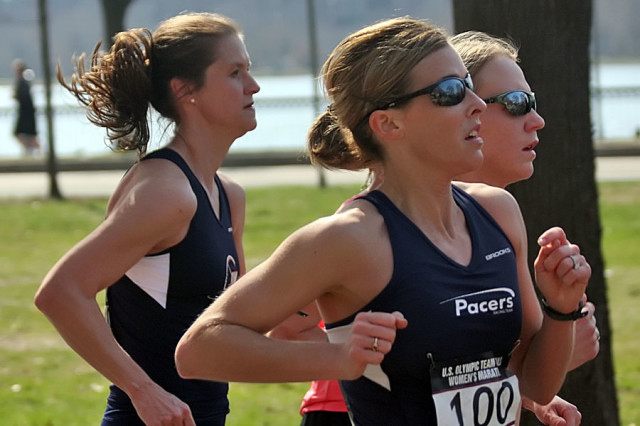
And the Answer Is…
This writer has run a number of marathons and if I had the answer as to how to run your best, I’d gladly share it. I’d also be a very rich man. Mostly, what I heard from the runners quoted above resonate with my marathon reality: train hard, be smart and get lucky.
More specifically, I ran Grandma’s on a tailwind day — unlike Raabe and embracing the luck of Phil Stewart — and rode that wave to an at-the-time personal best of 2:16. It should be noted that of the dozens of marathons I’ve run, that was the only one in which I ran negative splits.
I was also fortunate — or well prepared, take your pick — when I ran 2:16 and finished eighth at the 1992 Olympic trials marathon. That dispassionate and clinical description belies the fact that it was the race of my life.
I had determined early on to do everything within my control to make those trials my best marathon. Most importantly, and inexplicably to many of my friends and family, I quit my job in order to make training my sole focus. For several months, I ran twice a day and averaged more than 125 miles per week, which was manageable with a limited racing schedule, plenty of rest and the help of training partners and a great coach.
One month prior to trials, half a dozen of the best distance runners in Maryland gathered at a track in Rockville to knock out five repeat miles. A different runner led every interval but each mile was consistent at 4:45; I remember a group of high school kids apparently annoyed we were hogging their track but too intimidated by our effort to say anything.
Any lingering doubts regarding my fitness after that workout were dispelled when I finally raced 10K and easily beat a good field. I ran 30:16, 18 seconds off my PR.
But I was confident enough to pick myself to finish eighth in my best friend’s trials pool (yes, marathon geeks do that). On race day, I started conservatively while many others gambled that their best race would come off a fast pace on a warm morning. Anyway, I’ll always be proud of maximizing my marathon talent on the day and in the race when it mattered most.
So is there a secret to the marathon? Sure, lots of them. Always start with the Holy Trinity of miles, speedwork and long runs. Repeat for 10 weeks. Then add the equanimity and work ethic of Chris Raabe, the moxie and drive of Kristen Henehan, the talent and thoughtfulness of Karl Dusen, and most importantly two parts of Phil Stewart’s luck. With all that, you’re guaranteed to have a great race.
This story originally appeared in the July/August 2014 RunWashington.
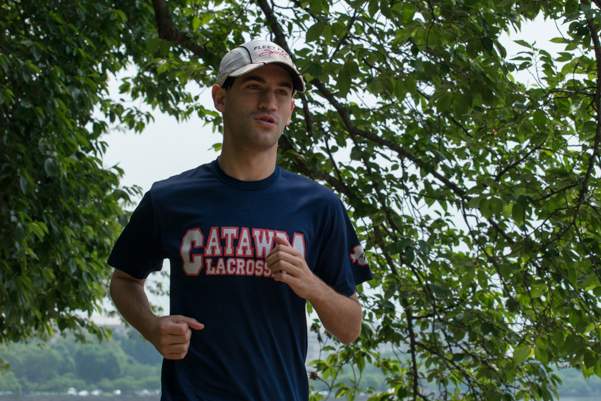
For most people, running remains a hobby at the end of the practice, the end of the race, the end of the day.
Not for David Finland.
“Running was a key thing for me,” he said. “I didn’t have anything to do. [Life] was kind of boring.”
He’s now completed five marathons, including the ING New York City Marathon and the vaunted Marine Corps Marathon.
Finland, of McLean, was four or five when his autism was diagnosed. The family’s doctor prescribed medications, but the drugs caused bouts of Tourette syndrome.
“They seemed to undermine his natural body rhythms,” said Glen Finland, David’s mother.
The family had also begun reading about research that detailed the positive effects of exercise for autistic children. Glen enrolled her son in soccer because his two older brothers played. The game didn’t stick.
“But boy could he run,” Glen said. “A beautiful runner. It surprised us all. We decided to drop the meds he was on.”
They called the new regimen “David Unplugged.”
At McLean High School, Finland served as a water boy for the football team. The track coach noticed Finland sprinting on and off the field.
“The speed he had,” Glen said, “it was a natural grace.”
The best medicine
At its core, autism is a disease of brain development that also affects motor skills.
The American Psychiatric Association released a new edition of its diagnostic manual in 2013 and officially changed the definition and criteria for the condition. Autism disorder spectrum, now referenced as autism spectrum disorder, better encompasses the range of symptoms and severity individuals express.
“Autism is not static,” Glen said. “It changes all the time. There’s always some new battle to fight.”
Running allowed Finland to become part of the mainstream society at the high school, an immense step for anyone who seeks a niche within the social groups of that formative time period.
He competed for the varsity cross country team and ran several distance events for the track team.
“It was huge,” Glen said. “This was his first taste of being a regular guy and all the personal freedom that went along with running.”
Running didn’t cure everything, though.
Kids still noticed some of his muscle ticks. Teammates started calling him Crazy Dave.
“That made me sick at heart,” Glen said. “He said the nickname made him cool.”
Despite any negative encounters related to the sport, Finland continued to run. He moved on to marathons in the years after his high school running debut. His first event was Marine Corps.
“I was really nervous and really not sure if I actually wanted to be there that day,” he said. “It was overwhelming. Mile number eight I started to feel more comfortable, and toward the end I realized, ‘Hey, I really like doing this.’”
When he trained for marathons, Finland ran eight to 10 miles in the evenings.
“My favorite run is along the Potomac River and running along the National Mall,” he said.
He’s planning on running New York this fall, but also wants to continue racing 5ks and 10ks, with a potential half marathon in the mix. He’s cut his training to five- and six-mile runs, plus stair workouts.
This type of routine seems commonplace for most active runners in the area, but the sport has created exceptional benefits for Finland. Running is the medication that keeps him at his best.
“My whole mind is clear,” he said. “It feels like a brand new start for me. After I’m done, I’m not thinking at all. My head is empty.”
That vacancy disappears on days when he can’t work out.
“It doesn’t feel good at all,” he said. “I’m a little bit angry. I’m a little bit confused. I’m a little stressed. There’s too much going on in my mind. I can’t concentrate.”
And if running were taken from him completely, “that would ruin my life right there. I wouldn’t be the same again.”
The need to run
Physical activity for anyone with a disability can become a challenge, one that negatively affects overall well-being.
A February 2014 study published in the Maternal and Child Health Journal looked at weight issues and learning disabilities. The study evaluated data from 9,600 people ages 12 to 17, with and without disabilities, from 2008 to 2010. Researchers found that nearly one-third of adolescents with autism qualified as obese.
And the problem could escalate.
Researchers have not yet been able to explain the rising numbers of autism diagnoses in this country. For instance, the current estimate of autism’s prevalence in the U.S. population is based on 2010 census data for 8-year-old children. Those children are identified under the pre-2013 definition of the disease, when a diagnosis referred to separate conditions such as Asperger syndrome. Although improved detection could contribute to the recent surge, that explanation does not rule out an actual increase in cases.
Academic research has shown that kids with ASD typically have fewer options for recreational physical activity, but the disease doesn’t preclude children from exercise. Underdeveloped social skills can limit participation more than physical impairments. For example, schools often host team-based athletics that rely on social cues and constructs.
“That’s the beauty of running,” Susan Pereles said. “You can do it as a solo activity. You can do it as a group.” Pereles is the field development director in the National Capital Area office for Autism Speaks, an advocacy organization that funds research and awareness activities.
Researchers have also identified positive attributes of an activity like running, including the fact that the rhythms match repetitive motions sometimes associated with autistic individuals and that the sport remains available to people throughout their lifetimes.
Even if an autistic person doesn’t always run with a group, he or she can take part in warm-ups, cool-downs and stretching.
“Running with a lot of people doing the same thing I’m doing is kind of a thrill for me,” Finland said.
He’s tried a few running groups, but he still prefers to train alone.
“I find it easier to run when you’re alone,” he said. “You’re not distracted by who’s running with you.”
Still, he hasn’t abandoned the prospect of having someone to match him stride for stride.
“Hopefully one day I‘ll have a running partner,” he said.
Until then, what Finland has acquired through running is a concrete sense of self-sufficiency. “You’re the only person you are in charge of. You don’t have anybody to tell you what to do or where to go. You’re running at your own convenience.”
That autonomy was something his mother both wanted and feared.
“It’s helped me learn to let him go,” Glen said, “to trust him more on his own.”
She wrote about that process — including her son’s first solo Metro rides and his pursuit of a driver’s license — in a memoir called Next Stop.
“On one hand,” she said, “I’m pushing him to do it. On the other hand, I’m crouching behind saying careful, careful. Parents of special needs kids find it a little more difficult because the stressors, the challenges are different.”
Many people contend that the car represents the quintessential American freedoms of movement and expansion. Runners might match their sport with the car. Finland accomplishes a bit of both.
His license plate reads MST FNSH.
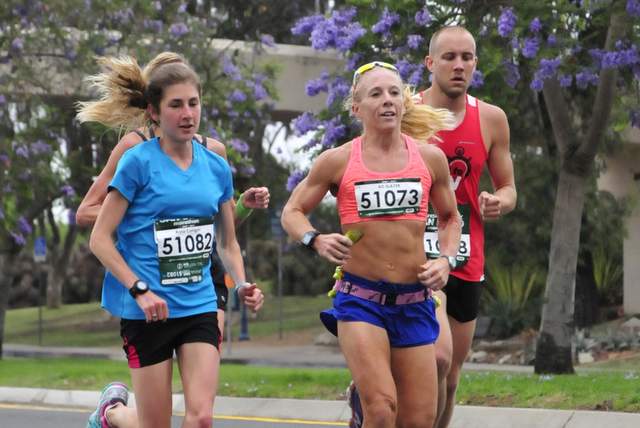
They started out six years and a few miles apart in Burke. In June 2014, they wound up almost 2,300 miles away, neck and neck at the Rock n’ Roll San Diego Marathon.
When Anna Corrigan and Bonnie Axman were cruising through the first miles, they had no idea that they were re-enacting battles between their rival high schools’ cross country teams — the Lake Braddock Bruins and Robinson Rams, respectively. They weren’t trying to break each other, though Corrigan had the lungs and Axman had the muscles to do so.
Back then, to think she’d be running a marathon was a stretch. In middle school, she wanted to be a sprinter, before her attempts in her track club demonstrated that her fast twitch muscles were too fast for her to catch. She tended to the longer races and made her name as a 10k runner at the University of Virginia and later, the University of California at Berkeley.
“Enjoyed it the most and it helped that I was the most competitive at that distance,” she said. “But I really did enjoy running it.”
Axman, 29, who couldn’t be reached for this story, was an All-American in cross country at Division III Frostburg State University and had run 2:45:56 in May 2014, capping off, for now, dramatic improvement in the marathon.
“I made friends with her pretty early in the race,” Corrigan, 23, said. “I had no idea we had grown up so close to each other until afterward. She was a few years ahead, so I never ran against her.”
During her junior year, assistant coach Mary Jane Reeves helped Corrigan put everything together and keep her in a sport that her father had initially encouraged her to pursue. After graduate school, she settled into a job as a systems analyst for an Arizona environmental engineering company and headed straight to the marathon.
“I wanted to do one without any expectations,” she said. “My only objective was to have fun.”
One way to do that is to skip the distances between, like the half marathon, a distance she eclipsed in her college long runs. She stuck to a routine of a long run every weekend, with speed work when she was able to make it to Phoenix Pheet track workouts.
“I was doing it all on feel,” she said, which all changed when the race began. An early downhill mile gave her a 5:37 split, shocking her.
About half way, at a water stop, Corrigan lost Axman and another woman. She spent the next few miles wading through the men falling back on the course. Within a few seconds of finding someone she thought would be a good pacing partner, he stepped off the course. At mile 18, she really felt alone.
“Those last six miles were harder than the first 18,” she said. “By then, I just really wanted to see my family and boyfriend. They were all over the course but kept missing me.”
A mile-long hill at 21 forged her into the runner who owned the last four miles, despite not having run more than 18 in training.
“It was a long highway stretch with nothing to look at,” she said. “After that, anything was better.”
She saw her sister and boyfriend at mile 24 and her parents at mile 25. A mile later, she broke the tape in her debut marathon at 2:44:27, less than 90 seconds off the Olympic Trials “B” standard. Axman was less than three minutes behind in 2:47:37. The Northern Virginia pair had swept a marathon across the country.
“I didn’t even know how close I was to the standard,” Corrigan said. “I just wanted to run a marathon.”
She wants to give it another shot, though her career may get in the way. She’s trying to find a way to manage her schedule to keep her working out regularly and out of the heat.
“It was 100 degrees in April,” she said. “Nothing like D.C. — 95 in Burke is more like 115 in Phoenix because it’s not humid, but it’s still pretty hot. It’s motivation to get up and run early.”
This story originally appeared in the July/August 2014 RunWashington.
Over five weeks this spring, Susanna Sullivan ran four races.
A nation-leading 26:51 at the St. Patrick’s Day 8k. A week later, second at Virginia Beach’s Shamrock Half Marathon in 1:14:22. After a break, second at the Collegiate Running Association championships at Richmond’s Monument Avenue 10k with a 33:42, a pace she nearly matched eight days later en route to a 54:31 finish at the Cherry Blossom Ten Mile, fourth place in the U.S. 10 mile championship race.
Two years ago, that would have been unthinkable. Not the times, but running two races, let alone four, in five weeks.
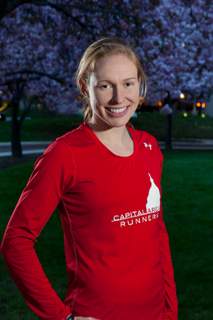
“I got so used to being hurt that if someone would talk about a race a month away, even if I was healthy, I could never get my hopes up or realistically think I’d be able to race it,” she said. “Even my first year after college, I expected to be broken in half a week later.”
But it didn’t happen, and now she has a race on her calendar more than a just few weeks away — Feb. 13, 2016 in Los Angeles– the U.S. Olympic Marathon Trials. Her time at Shamrock — the race she thought was the worst in that stretch — won her an invitation, and as she approaches two years since her post-collegiate running career began, she’s enjoying training consistency she hadn’t known since she left for Notre Dame.
Following her successful career at George Mason High School, she had every reason to expect dramatic improvement.
“I assumed I’d have people to run with, and with their coaches and facilities, I thought it would be perfect, being surrounded by people who were competitive,” she said. “It didn’t turn out to be what I expected.”
While her times did improve, it wasn’t a smooth ride. As injuries invariably followed her good training weeks, she broadened her life away from the track so that the times she’d be forced from it wouldn’t be as distressing. With a few months to go before graduation, a broken foot sidelined her for most of her last semester, but the way she answered set the stage for her future.
“I figured I could mope around with a broken foot and wear a boot at graduation, or see what I could do,” she said.
Sullivan put in several hours a day in the pool and the Alter-G treadmill, working like a maniac, as she put it. All for the hopes of a few more chances to race. Not the routine of a senior who had checked out.
And it paid off. She ran at the Big East championship meet and scored her only collegiate victory at her final race –at Grand Valley State — before coming home to Falls Church with physiological momentum but emotional uncertainty.
Desperate to break out of her malaise, wanting to run fast but shy of putting herself out there again, she considered transitioning to running for fun, maybe picking up ballet and French classes, but she couldn’t see herself putting running too deeply into the background.
“I love running more than anything in the world,” she said. “I thought that maybe, when running is just fun, when there are no expectations, it would stop being so frustrating,” she said. Soon after coming home, she joined the Capital Area Runners and found coach George Buckheit‘s approach to be exactly what she needed.
“He knew where I was coming from — a place of deep frustration,” she said. “Everyone has fun at CAR, but he made sure I stayed relaxed.”
Buckheit also saw what the problem was, and how her spring led her on the way to fixing it.
“Like many distance runners, she would always pound herself until she got injured and she was injured frequently,” he said. “She did way too much anaerobic work and had way too few recovery days built into her training.”
Her first summer, she committed to building an aerobic base, one she found herself missing when she tried frantically to catch up following collegiate injuries.
“It was a bit of a battle to convince her that she could race a lot faster if she simply slowed down her training but did more of it, but she’s become more and more confident with that approach as she’s continued to see her PRs improve,” Buckheit added. “Even though she’s almost doubled her total weekly training volume, she’s putting less total stress on her body by pulling back on the anaerobic work and making sure that her recovery days truly are easy aerobic days.”
Within her first few weeks, Sullivan was cashing in that time she banked in the pool and on the treadmill, taking off immediately in her new training environment.
“I didn’t even look at the workouts until I got to the track, there were very competitive people, but nobody takes it over the top. It was so refreshing,” she said. “I was sold from day one.”
All the while, she’s been spending her days on her feet as a kindergarten teacher in Fairfax County.
“I’ve wondered if it’s good for running, bad for running or neutral, and I’ve come to the conclusion that it benefits (running),” she said. “I read about how sitting is crummy for everything. Steps divide our classroom — it’s like I do box steps all day.”
She relishes working with her co-teacher, whom she calls “a master of kindergarten.”
“I love early brain development and it’s really cool to watch the kids put it together, make the little connections and see them become big connections,” she said.
Sullivan has put a few things together, too.
Her first half marathon — the 2012 Rock ‘n’ Roll Philadelphia Half — was long enough to seem like a challenge, but her sub 1:20 time convinced her, and Buckheit, that she had an aptitude for long distances. Over the next year, she set PRs in every distance and became a regular on local podiums. During her return to Philly in 2013, she took a swing at the Olympic Marathon Trials B standard half marathon time of 1:15. A side stitch in the last mile kept her from closing, but in the process she topped local Olympic 5k runner Julie Culley and marathon trials qualifier Christine Ramsey.
From there, she focused on Shamrock, in March 2014, set on solving that last mile and earning her ticket to the trials. Memories of rough half marathons before dogged her, but she was fortunate to miss the savage ocean wings that plagued marathoners later that morning.
“I feel so blessed that the worst race (in her five-week spring season) would end up as a trials qualifier,” she said. “I felt like I was uptight the whole race, I didn’t know when I’d “have it.’ But, when I was two miles from the finish, I thought I’d really have to screw this up.”
Ahead of Cherry Blossom, Buckheit told her not to be surprised if she was running her 10k pace. When Sullivan found the pack of Americans chasing eventual champion Janet Bawcom and Sarah Hall, she thought it “was cool to be racing with these women who were pretty good,” including national-class runners Frances Koons, Brianne Nelson and three-time Olympian Jen Rhines.
“I felt like it was inevitable that I was going to be dropped, but the longer I held on, the better my time was going to be,” she said. “At five miles, I knew I could hang in until eight. With just under a mile to go, I thought I would give it a shot. I wasn’t pulling away too much. I don’t know why I made a move.”
Though she lost to Koons in a kick, she finished ahead of Nelson and Rhines, and probably made the difference between fourth place and farther back in the pack.
“George told me to be brave, and that’s been the theme the past month — getting in and rolling with girls I don’t think I can race with,” she said.
Now she sets her sights on the big one — the marathon. She’s going to try it out before the Olympic Trials, and plans on October’s Twin Cities Marathon. As she advanced her mileage, she scratched 95 miles a week earlier in the year, to see how her body reacted and give her a preview of training for 26.2 miles.
“The marathon, I wasn’t really sold on it until this string of races,” she said. “At this point I trust anything that comes out of George’s mouth. If he says I can do it, I’m going to try.”
This story originally appeared in the May/June 2014 RunWashington.
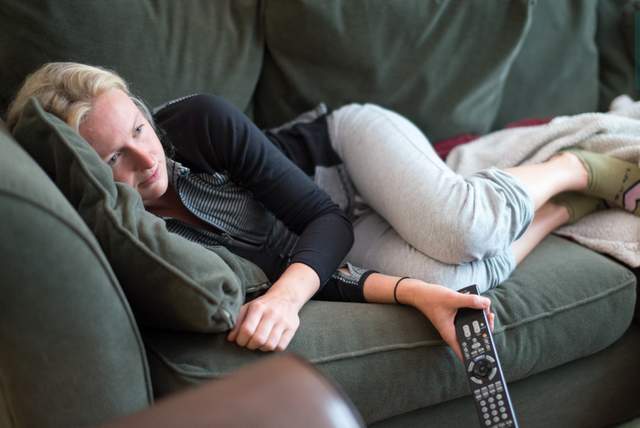
Some Boston Marathon hopefuls had to deal with heartbreak long before they reached the eponymous hill in Newton.
While Boston always carries a special significance, runners this year were even more determined to prove the running community’s resilience after two bombs went off at the finish line in 2013. Some, however, were sidelined by injury after months of training and anticipation for what they expected to be one of the most emotional and memorable marathons of their lifetime.
“It wasn’t until I signed up and was registered that I started to really feel the impact of how special an opportunity it would be to run this year with everything that has happened and just how emotional and special it’d be this year,” said Phoebe Markle, an Alexandrian who was set for her first Boston. “To be a part of that, I don’t take that for granted.”
She made it through 13 weeks of training when she ran a 22-mile long run a little too fast and felt some pain in her calf. She tried to push through, not wanting to miss out on training so close to the race. But eventually, she had to confront the reality that she may not be able to run. She went to the doctor and the problem was diagnosed as a strained calf.
Whether she would run was up in the air until just a few days before the race, when her physical therapist told her not to run, worried it could be a stress fracture. Discouraged, she felt like all the hours and miles logged were for nothing.
“That was my priority, training through the winter. I got in every workout through the polar vortex, in the ice, wind, snow,” she said.
She has already qualified for the 2015 Boston Marathon and said she will try again then and “train smarter.”
With plans to drive to Massachusetts with her boyfriend and stay with friends, Markle was, financially, just out her entry fee. Others weren’t so lucky and had far less flexible travel plans. When Emory Ford of Kensington got hurt about a month before the marathon, he forfeited his entry fee and the cost of his travel plans and hotel for the weekend.
“It was an expensive choice to not run and to cancel my plans,” he said.
Ford was skiing with his son in West Virginia when he landed wrong and injured his back.
“Something I probably shouldn’t have done — a ski jump,” he said. “I landed on my back. I’ve been having issues with my sciatic nerve, it’s hard to stand up and sit down and it causes my calf muscles to tense on the left side.”
He wasn’t able to run at all with the injury and realized he would not be able to do the marathon, though he said he’ll likely try to run it next year.
“It’s too bad I couldn’t go this year, though, because I’m sure it’s going to be extra special,” he said.
For Mike Gorfinkle, running Boston this year was about finishing what he started in 2013. He ran for a charity in honor of his cousin who died of cancer and was about half a mile from the finish line when the the bombs went off. Now an Ellicott City resident, he grew up in Boston watching the race, and was one of 5,000 runners who couldn’t finish last year and was invited back in 2014, but ran into trouble when he strained his Achilles tendon playing with his daughter after a long run.
“Any other race, I would just wait for the next one and get better,” he said. “But for this race, I’m not by any means a professional athlete, but it’s like playing in a big game.”
His doctor told him that under any other circumstances, he would advise Gorfinkle not to run, but that he understood this was a “once-in-a-lifetime” race. Determined to run the race, Gorfinkle abandoned his sub-four hour goal and planned on taking walking breaks every two miles.
“I figured I’ll run as far as I can until I can’t anymore, and then I’ll drop off at a medical tent,” he said before the marathon. “Normally when I run races, there’s some competition to it, but for this race, it’s more about being there for the day and celebrating and remembering what happened last year.”
Gorfinkle finished the marathon in 5:46. He said it was very difficult to run through his injury and even had to stop at a medical tent along the course to ice his Achilles tendon for about 20 minutes.
“But I made it,” he said.
Arlington’s Daryle Lademan also managed to cross the finish line in Boston, despite battling injuries for almost three months. In February, she was out of training for about three weeks with shingles, then just a few weeks later, starting having pain in her IT band. Though her coach didn’t approve, she made a last-minute decision to run, “because it was Boston.”
While she initially just flew in to pick up her number and maybe run the B.A.A. 5k two days before, she ended up on the bus to the starting line in Hopkinton the morning of the marathon.
“I had a $20 bill in my sports bra. I figured, worst case, I pop out at the halfway point and take the T back to Boston,” she said. “I got to the halfway point and (her IT band) was doing alright; it probably was adrenaline. I just sucked it up and went all the way to Boston.”
In addition to wanting to participate in this year’s marathon to take back the finish line, Lademan had the added motivation of having to pull out of last year’s marathon two weeks before the race with another injury.
“I thought ‘No, damnit, I’m not sitting this one out,’” she said. “I was bound and determined to pull out all the stops to make it happen it year.”
She went out without a time goal and ended up finishing in 3:42 – not a personal best time by any means, though it was definitely a personal best race experience.
“It was absolutely the hardest race, but also the most life-affirming race I’ve ever run,” she said. “The thought that I might have not run it, or might not have given it a try because I wasn’t well trained, or I wasn’t going to PR, my heart just breaks thinking about that because I would’ve missed out on the best running experience of my life.”
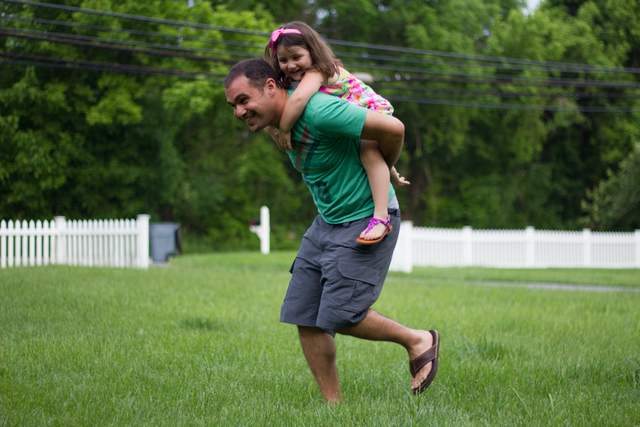
This story originally appeared in the July/August 2014 RunWashington.
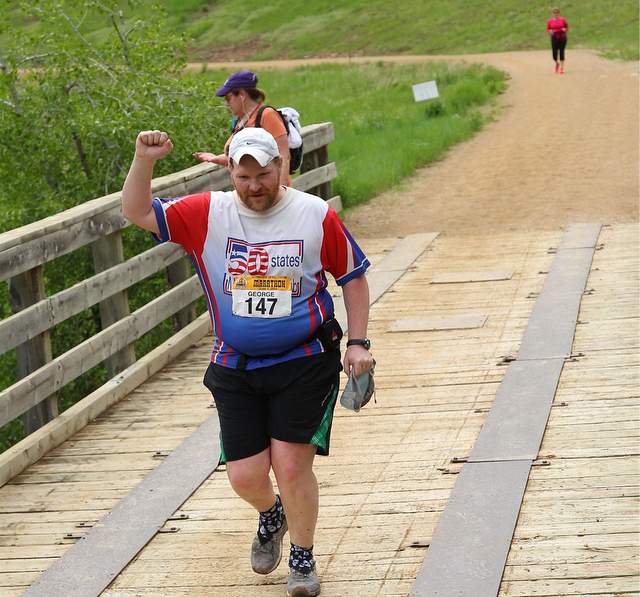
The bananas and bagels are almost gone and the band, if there is one, is wrapping things up. The finish line is about to come down, but here comes Ted Hobart.
The native Arlingtonian’s size would throw off most people if they guessed his sport — he was a football player at Washington-Lee High School — but with more finishes than most in the running-crazed D.C. area, Hobart is undoubtedly a marathoner. He hit number 66 in early June at the Deadwood Michelson Trail Marathon in South Dakota and 67 at the Run4Troops marathon in Iowa four weeks later. He typically runs under the name George.
Often, he’s the race’s encore, finishing last in 12 of his marathons. At the Clarence DeMarr Marathon in New Hampshire, he was awarded with a turtle trophy, painted on a rock by seven-time Boston Marathon champion DeMarr’s daughter. It was the first time he had won an award for a DFL. “D” stands for “dead,” “L” stands for “last.” Use your imagination on “F.”
“They played the Olympic theme as I crossed the finish, with all the volunteers cheering me on,” he said. “Usually everyone is gone when I get to the finish, but this race was something pretty special.”
But he embraces it. His modesty won’t allow him to admit it, but it’s hard to believe that he doesn’t take some delight in knowing that he proves people wrong.
“It’s never been easy for me,” Hobart said with a laugh. “When I go to marathons, people will look me up and down and ask if I’m running the 5k. Then when I tell them that I’m here to run a marathon, they assume it’s my first one.”
He looks like a bearded Andy Richter, with hair that, at 47, has migrated from the top of his head down into a long ponytail.
“You might wonder how I can continue to run in the back of the pack and still have a smile on my face,” he said. “It’s because I have so many things to be thankful about, like having the ability to go the distance and my determination is never an issue it’s my passion to keep going and I hope to continue running for many more years.”
Sometimes he turns some noteworthy performances with those DFLs. The 2011 Mad marathon in Vermont gave him bib number one, the opposite of his finish position. Six days later, and at the Grant-Pierce Indoor Marathon in Arlington, he managed last place and a top-10 finish.
In 2013 alone, he finished 16, in 16 states, on his way to finishing a 50-state marathon quest he’s been running in memory of his friends Julie Williams and Lollie Winans, who were murdered while hiking the Appalachian Trail in 1996. The brutal crime remains unsolved.
Hobart and Winans met as students at Vermont’s Sterling College in the ‘90s, and a strong friendship quickly ensued. When Winans and Williams began to date, Hobart wasted no time befriending Williams. He even asked the two to come visit him in North Carolina at some point during their hike, but they didn’t make it that far.
Their lasting memories give Hobart the steam that keeps him going. He dedicates a marathon each year in their honor, which, for him, is far more meaningful than any finish time or medal he wins.
“I think of Lollie and Julie every day,” Hobart somberly said. “Their strength and love for life motivates me every time I run a marathon.”
He started running after seeing an advertisement for an AIDS marathon training course plastered on the wall of a Metro car in 2004. He’s the event and corporate fundraising coordinator for Whitman-Walker Health, a community health center that focuses on serving the LGBT community. Hobart never considered long distance running, and hadn’t been athletic since junior varsity football, but something about the advertisement piqued his interest. So he embarked on a new adventure: training for his first marathon in New Orleans. After eight months of rigorous training, the vision morphed into reality as he ran his first marathon. And while he claims that he and his family don’t share the same passion for long-distance running, he says they have come to a mutual understanding.
He plans to complete his 50-state journey in Maine, where Winans and Williams met, at the 2016 Mountain Desert Island Marathon. The race will fall on the 20-year anniversary of their deaths. Hobart will also celebrate his 50th birthday that year, and though he is on pace to finish his 50 marathons ahead of time, he is holding up to coincide with that anniversary.
“It’s going to be an amazing and emotional time,” Hobart said. “I wish I picked an easier way to honor my friends’ lives, but then again, running 26.2 miles across America is a pretty awesome way to show (them) how dedicated I am to finding strength and peace.”
He’s coming up on 10 years of these races. His Marathon Maniacs page, on which he nicknames himself “Dead Last Monkey,” chronicles each race. His remarks for races demonstrate why his times don’t faze him — he clearly loves a challenge and relishes overcoming tough conditions.
“Running marathons gives me a sense of peace, that Zen moment to myself,” Hobart said. “I am not a fast runner, but it’s the courage and determination that I bring to all my marathons that allows me to finish strong and with a smile on my face.”
In Deadwood, he found himself in the running for another DFL when he came across a first-time marathoner, Cynthia. She was having a rough time, and he drew on his 65 marathons of experience and counseled her through it.
“I told her that even if I moved ahead, she should just keep me in sight,” he said. “In the last few miles, I got away from her, but she finished.”
Elton Hayes contributed to this story.
This story originally appeared in the July/August 2014 RunWashington.
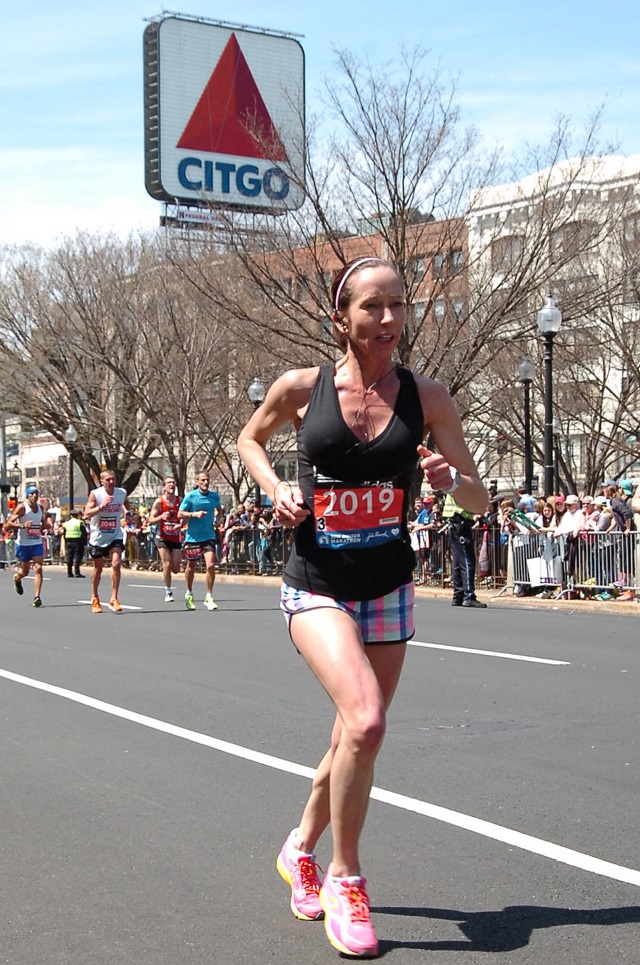
The next time you’re struggling to hit a personal best or succeeded in any distance – let alone the marathon – remember Kara Waters.
[button-red url=”http://www.runwashington.com/2014/04/21/dc-area-boston-finishers/” target=”_self” position=”left”] See all of the D.C. area’s local Boston finishers[/button-red]Waters is a 39-year-old physician, a single mom to four without a coach or running club, and still was able to run a 2:52:29 in Monday’s Boston Marathon.
The mark was the top time for a Washington-area female at the 118th running of the race.
“I had no idea,” Waters said of being the area’s top woman finisher in an interview this week. “With the race this year, I wasn’t really focused on my time. I think it was more the experience like everyone else.”
Hoping to maybe break three hours, she hit the halfway point feeling good, felt the same way at the three-quarter mark, and knew a good time was within reach. She decided to push the last six miles and ended up the 63rd woman overall.
In fact, she ran pretty even splits throughout the race, roughly 20 minutes for every five kilometers.
“I told myself if I feel good by mile 20 or mile 21 after getting over Heartbreak Hill I’m going to try to really race the last 5 miles or 10K,” said Waters, who makes her home in Great Falls. “And the last two miles I felt good. There were no real hiccups.”
The unusually high number of runners in this year’s race — which swelled to 36,000 — probably helped her, she said. Because her corral was more packed than usual, she couldn’t run as aggressively as usual in the first few miles, which helped her at the end of the race.
The last several miles of the race carried the same vibrant, up-lifting atmosphere as when the race passes the college campuses of Wellesley and Boston College — people rows and rows deep on both sides of the street. There were numerous events and tributes honoring those who were injured or killed in the bombings last year.
“This year it was unbelievable,” she said. “It was nothing else that I had seen.”
Waters felt compelled to call her children multiple times a day before the race just to share her emotions. The overall atmosphere certainly helped her performance, she said.
Waters specifically remembered running past an amputee – a presumable survivor, she said – at mile 18, running for Martin Richard, the 8-year-old boy who died last year.
“I might have run an okay time, but some of the things these people are doing is amazing,” she said.
Somehow, Waters manages to juggle being a single mom to four girls – ages 9, 8, 6, and 5 — with a training schedule necessary to be a top-100 finisher at the country’s most prestigious road race.
On top of that, she is also a radiologist in Clinton, Md. She is admittedly not a high-mileage runner and uses “a whole lot of treadmill training” and running solo. She runs at night after she puts the kids to bed or outside on days she doesn’t have them.
“I don’t feel like I’m juggling more than other people,” Waters said. “I think everyone’s life is busy and running is part of my life, part of day, so I finagle it in whenever I can.”
But that’s her demeanor, humble and thankful.
Waters ran track at Colby College in her home state of Maine. She started off in the 400 meters but eventually moved up to running the 5k and 10k by her senior year.
She left school as a two-time All-American in cross country and more honors in indoor and outdoor track in the 1500 meters.
She ran with the Boston Athletic Association after college before going to medical school at Dartmouth Hitchcock Medical School in New Hampshire.
Waters ran her first marathon in Portland, Maine after becoming a doctor and before taking time off to have her four girls.
She has slowly started to get more and more back into road racing but admits that she still doesn’t race all that much. Waters only moved closer to the D.C. area about two years ago and is still trying to find her footing in the local racing scene.
She used to run with the Howard County Striders when she lived in Ellicott City for more than three years. She recently started to run with the Potomac River Running racing team.
“I haven’t had a coach,” Waters said with a laugh. “I probably should.”
Maybe she can increase her mileage – which was six or seven long runs with some mile repeats thrown in while training for this year’s Boston Marathon – so she can meet running goals like qualifying for the U.S. Olympic trials.
This was Waters’ third Boston Marathon. She finished with a 2:58:50 last year and 2:52:05 in 2011 – a mark that’s still a personal best in the distance – when she was the 47th woman overall.
Waters would love to at some point in the marathon and qualify for the U.S. Olympic trials in the marathon. But that would require a 2:43:00 for the “B” standard.
For now, she has her sights sets on the North Face Endurance Challenge in June and some local 10ks and half marathons later this year. Which ones specifically, she doesn’t yet know.
She plans on running the Marine Corps Marathon this fall, where two years ago she clocked a 2:52:32 and placed fifth overall for women.
The 2:52 mark in the marathon is something she can’t seem to overcome, hitting it several times in the last few years. It’s the wall she hasn’t been able to knock down. She has still managed to accomplish a great deal for any runners’ standards – let alone a single mother who busy, full-time physician.
I’ve done my best to compile the Boston results for D.C.-area runners, roughly Washington, D.C., Prince George’s and Montgomery County, Md. and in Virginia, Fairfax and Arlington counties, Alexandria, Falls Church, Manassas and Manassas Park and parts of Loudoun and Prince William counties. Please comment if I have omitted you.
Of the 851 local runners registered, 745 finished, with a median finishing time of 3:36:27.
Here are the D.C. area’s top 10 Boston Marathon finishers and the top finishers from each state
|
|
District of Columbia
Patrick Kuhlmann(113th) 2:31:31/Julie Tarallo (68th) 2:53:14
Virginia
Michael Wardian (35th) 2:23:32 / Kara Walters (63rd) 2:52:29
Maryland
Tom Dichaira (93rd) 2:29:49/ Lisa Reichmann (300th) 3:08:23

